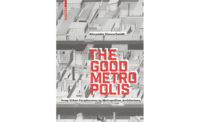Review of 'The Shenzhen Experiment: The Story of China's Instant City'
By Juan Du

The Shenzhen Experiment: The Story of China’s Instant City, by Juan Du. Harvard University Press, 384 pages, $35.
In the summer of 2005, Princeton-educated architect Juan Du was recruited to the burgeoning Chinese megacity of Shenzhen to curate an urbanism exhibition celebrating the 25th anniversary of its founding. Shenzhen’s salute to itself would visually recount its origin myth—how reformist premier Deng Xiaoping’s dream of a paint-by-numbers metropolis springing from virgin land near the Hong Kong border came to pass. Opened as a market-friendly “special economic zone” in 1981, the upstart city was already on track to eclipse New York in population. As a swaggering 25-year-old, Shenzhen touted itself as a model—a centrally planned SimCity whose success could be replicated all over China, maybe even the world.
After taking myriad study tours of Shenzhen’s skyscraper-studded sprawl with municipal officials, Du missed a flight out one fateful night and began wandering the back alleys alone. There, hidden behind walls in the automobile-dominated, self-consciously “modern” metropolis, she found an informal world of deep-rooted urban villages teeming with pedestrian-packed open-air night markets. Circling back today, a decade and a half after mounting her government-backed exhibition, Du has published a myth-busting history of Shenzhen that highlights the interplay between the region’s centuries-old villages and the vaunted “instant city” layered over them.
Despite the urban legend that Deng Xiaoping founded Shenzhen by drawing a circle on a featureless map, the actual urban plan incorporated the layouts of villages that long predated the special economic zone. To this day, the footprints of the original villages remain evident, even as taller buildings have been extruded from them as savvy villagers cash in, developing their now-prime real estate. Similarly, the locations of the modern city’s parks, Du wisely notes, mirror those of the orchards and farm fields that once surrounded the villages.
Du convincingly argues that the city took on a life of its own, far exceeding its planners’ blueprints. Easing migration regulations led to an unprecedented flood of humanity as the young and hungry flocked in from all over China. By 2000, the city boasted 6 million residents, 20 times the planners’ 1979 goal.
The shift toward a market economy also came less from on high and more on the fly. One entrepreneurial construction manager wondered if workers might finish projects on time if they got bonuses. The answer was yes. Soon developers began speaking of the “Shenzhen speed”—a new high-rise floor built every three days.
Du’s focus on the enduring urban villages is a useful corrective to the propagandistic fiction of the ex nihilo city but, at times, her book crosses into overcorrection. The credit for Shenzhen’s breakneck growth doesn’t belong to Deng or his planners—or to Du’s villagers. Instead, it’s the urban newcomers, who move to the experimental city and live in the makeshift rental housing the urban villagers build, who are the soul of Shenzhen. Du briefly notes the migrants who have brought their “spicy Sichuan hotpots, steaming Shandong dumplings, smoky Mongolian barbecues, and sweet Guangdong dessert[s]” to the alleyways of Shenzhen, but she sidelines them as so much B-roll footage in her documentary when they should be its primary focus. E.B. White famously observed that natives, commuters, and transplants all rub shoulders on the sidewalks of New York, but it is the transplants who give the city its ambitious character. Likewise, what makes Shenzhen Shenzhen is its migrants.
Still, debunking the myth of Deng and his all-seeing planners sketching a tabula rasa metropolis is welcome. Deng never actually drew that circle on the map. Instead, a quote attributed to him better sums up the improvisational history of Shenzhen: “We are crossing the river by feeling the stones.”


